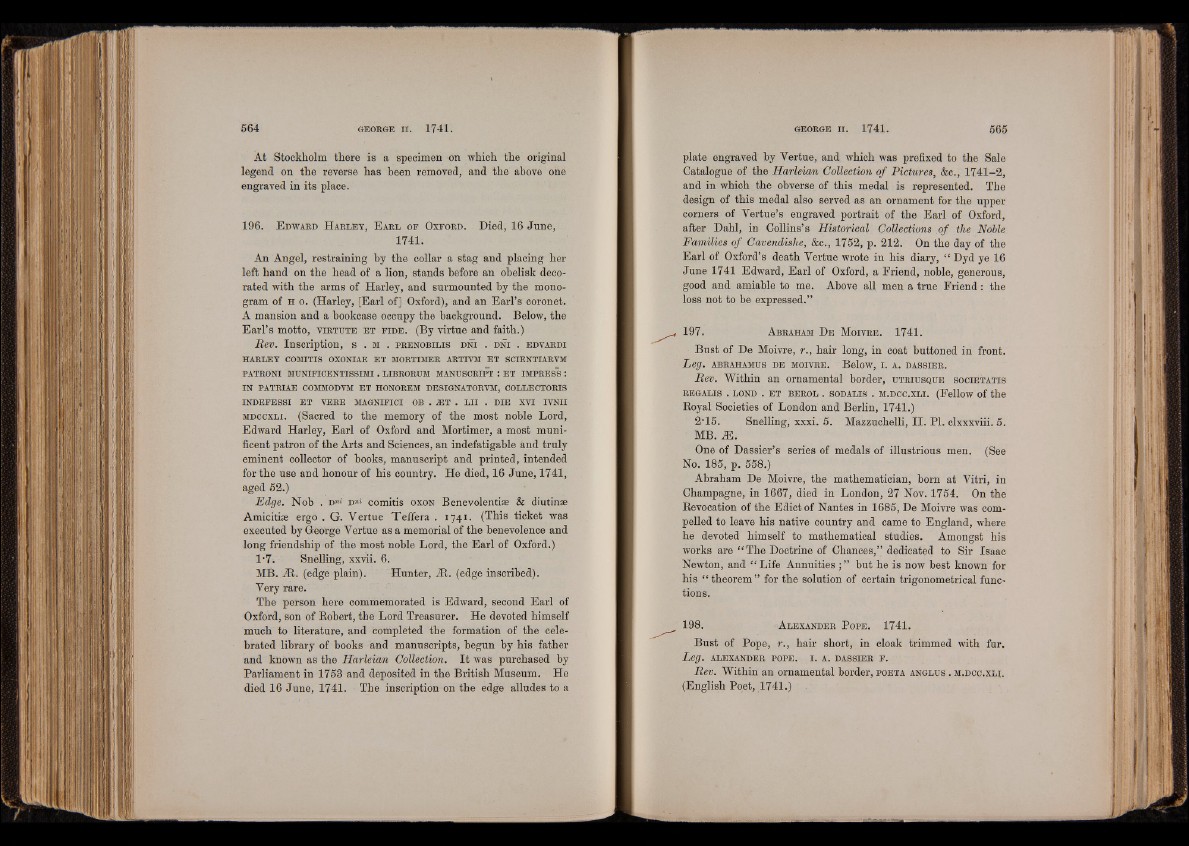
At Stockholm there is a specimen on which the original
legend on the reverse has been removed, and the above one
engraved in its place.
196. E dw ar d H a r l e y , E a r l o f Ox f o r d . Died, 16 June,
1741.
An Angel, restraining by the collar a stag and placing her
left hand on the head of a lion, stands before an obelisk decorated
with the arms of Harley, and surmounted by the monogram
of h o. (Harley, [Earl of] Oxford), and an Earl’s coronet.
A mansion and a bookcase occupy the background. Below, the
Earl’s motto, v lr tu t e e t f i d e . (By virtue and faith.)
Rev. Inscription, s . m . p r e n o b il is d n i . d n i . e d v a r d i
HARLEY COMITIS OXONIAE ET MORTIMER ARTIVM ET SCEENTIARVM
PATRONI MIINIFICENTISSIMI . LIBRORUM MANUSCRIPT : ET IMPRESS :
IN PATRIAE COMMODVM ET HONOREM DESIGNATORVM, COLLECTORIS
INDEFESSI ET VERB MAGNIFICI OB . iET . L II . DIE XVI IVNII
m d c c x l i. (Sacred to the memory of the most noble Lord,
Edward Harley, Earl of Oxford and Mortimer, a most munificent
patron of the Arts and Sciences, an indefatigable knd truly
eminent collector of books, manuscript and printed, intended
for the use and honour of his country. He died, 16 June, 1741,
aged 52.)
Edge. Nob . vni vni comitis oxon Benevolentiae & diutinae
Amicitiae ergo . G. Vertue Teffera . 1741. (This ticket was
executed by George Vertue as a memorial of the benevolence and
long friendship of the most noble Lord, the Earl of Oxford.)
1-7. Snelling, xxvii. 6.
MB. At. (edge plain). Hunter, At. (edge inscribed).
Very rare.
The person here commemorated is Edward, second Earl of
Oxford, son of Robert, the Lord Treasurer. He devoted himself
much to literature, and completed the formation of the celebrated
library of books and manuscripts, begun by his father
and known as the Harleian Collection. It was purchased by
Parliament in 1753 and deposited in the British Museum. He
died 16 June, 1741. The inscription on the edge alludes to a
plate engraved by Vertue, and which was prefixed to the Sale
Catalogue of the Harleian Collection of Pictures, &c., 1741-2,
and in which the obverse of this medal is represented. The
design of this medal also served as an ornament for the upper
corners of Vertue’s engraved portrait of the Earl of Oxford,
after Dahl, in Collins’s Historical Collections of the Noble
Families of Cavendishe, &c., 1752, p. 212. On the day of the
Earl of Oxford’s death Vertue wrote in his diary, “ Dyd ye 16
June 1741 Edward, Earl of Oxford, a Friend, noble, generous,
good and amiable to me. Above all men a true Friend: the
loss not to be expressed.”
197. A braham D e M o iv r e . 1741.
Bust of De Moivre, r., hair long, in coat buttoned in front.
Leg. ABRAHAMUS DE MOIVRE. Below, I . A. DASSIER.
Rev. Within an ornamental border, u t r iu sq u e so c ie t a t is
REGALIS . LOND . ET BEROL . SODALIS . M.DCC.XLI. (Fellow of the
Royal Societies of London and Berlin, 1741.)
2‘15. Snelling, xxxi. 5. Mazzuchelli, II. PI. clxxxviii. 5.
MB. M.
One of Dassier’s series of medals of illustrious men. (See
No. 185, p. 558.)
Abraham De Moivre, the mathematician, born at Vitri, in
Champagne, in 1667, died in London, 27 Nov. 1754. On the
Revocation of the Edict of Nantes in 1685, De Moivre was compelled
to leave his native country and came to England, where
he devoted himself to mathematical studies. Amongst his
works are “ The Doctrine of Chances,” dedicated to Sir Isaac
Newton, and “ Life Annuities ; ” but he is now best known for
his “ theorem ” for the solution of certain trigonometrical functions.
198. -A l e x a n d e r P o p e . 1741.
Bust of Pope, r., hair short, in cloak trimmed with fur.
Leg. ALEXANDER POPE. I . A. DASSIER F.
Rev. Within an ornamental border, po e t a a n g lu s . m .dc c .x l i .
(English Poet, 1741.)